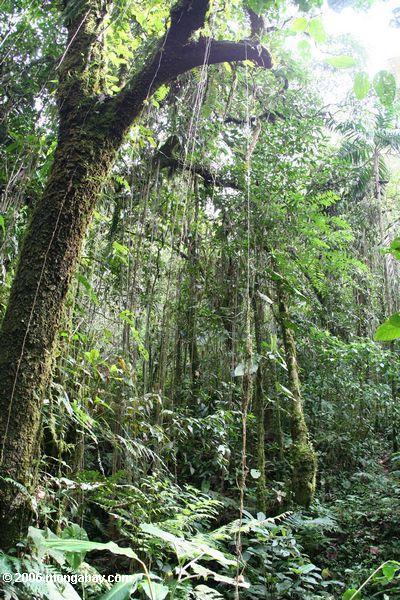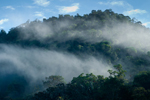One of the richest ecosystems on the planet may not survive a hotter climate without human help, according to a sobering new paper in the open source journal PLoS ONE. Although little-studied compared to lowland rainforests, the cloud forests of the Andes are known to harbor explosions of life, including thousands of species found nowhere else. Many of these species—from airy ferns to beautiful orchids to tiny frogs—thrive in small ranges that are temperature-dependent. But what happens when the climate heats up?
“Shifts in temperature will require upslope migration for most species to remain in equilibrium with climate and therefore potentially avoid extinction,” the scientists write in the paper.
However looking at aerial photos and satellite imagery of Manu National Park from 1963 to 2005, the researchers found that Andean cloud forests may run into an insurmountable border as they attempt to migrate up mountain sides: puna grasslands. Although the temperature has warmed significantly since the 1960s, the researchers found that the treeline bordering the Andean cloud forests and high-altitude grasslands had hardly moved. In fact, according to the research, 80 percent of this border remained stable in the study area since 1963. This transition area between one ecosystem (cloud forest) and another (puna grasslands) is known to scientists as an ecotone.

Cloud forest and valley in Andean Peru. Photo by: Rhett A. Butler.
“Previous work we’ve done shows that the trees in the forest are migrating upwards [in response to climate change], but this work shows the ecotone isn’t,” notes co-author Miles Silman with Wake Forest University. “The ecotone presents a wall to species migration.”
While Andean trees are already moving rapidly upslope in response to climate change, they have not been able yet to penetrate the ecotone barrier, according to the study. The scientists aren’t certain why the puna grasslands aren’t making way for cloud forests more rapidly as temperatures rise, but it appears that this colonization needs considerably more time than cloud forests species have under current climate predictions.
“From a biological perspective, cloud forest tree seedlings have major difficulty establishing themselves in puna grassland,” lead author David Lutz explained to mongabay.com. “The exact reasons why are still a subject of debate among plant physiologists, but generally field work has found the survival of tree seedlings to be low when exposed to the open sky in puna. Instead, tree seedlings fare far better under the forest canopy, indicating that a slow prolonged march, generation by generation, has been the typical mode of movement, often out from isolated patches who weathered the change in climate in a sheltered spot.”
In the past, cloud forests were able to make this march, as climate changed relatively slowly. But the pace of climate change today could simply outstrip the forests ability to migrate into the grasslands, notes Lutz.
 Cloud forest in Colombia. Photo by: Rhett A. Butler. |
“Historically, with slow rates of change, forests and puna have been able to shift up and down accordingly with likely minimal issue. Current rapid climate change projections, however, indicate that these cloud forests will need to move upslope at a very fast pace. Unfortunately, these tree species are not evolutionarily prepared to move this quickly.”
Human practices are likely exacerbating the situation, according to the researchers. Cattle grazing and manmade fires are commonly employed in puna grasslands. These practices “entrench puna grass species and eliminate tree seedlings, adding another wrench in the spokes for upslope migration of cloud forest trees,” says Lutz.
In fact, the researchers found that cloud forests migrated into grasslands slightly faster in protected areas—however still not nearly quick enough to keep pace with anticipated climate change.
“Even when a majority of the disturbance from grazing and fire were removed in Manu National Park, forests migrated upslope extremely slowly, at a rate of just around a quarter of a meter upslope per year,” Lutz explains. “To put that in perspective, this pace is around 2% of what it needs to be to stay in equilibrium with climate change by 2100.”
Given that a significant measure of further warming appears unavoidable at this point, the question now facing scientists and conservationists is how to proceed. Does the world allow cloud forests to vanish or is it time to actively move species past the ecotone barrier?

Orchid in the cloud forest near Machu Picchu. Photo by: Geoff Gallice/Creative Commons 3.0.
Before anyone starts planting trees, however, Lutz says that a number of questions need to be answered about how to help cloud forests move into the grasslands.
“For instance, there are hypotheses that high levels of solar radiation make it difficult for tree seedlings growing in the puna to survive. If that is the case, perhaps a good strategy may be to construct semi-transparent screens to create migration corridors,” he explains. “Another hypothesis has to do with the rhizomatous form of the tussock grasses that inhabit the puna, which make it difficult for tree seedling roots to establish. In that case, perhaps plowing these grasses out may be a good way to encourage tree migration. Right now I’m hesitant to suggest that any methodology is the silver bullet.”
The ongoing research hinted at another possible—and unexpected—way to move cloud forests over the grasslands barrier: landslides. Observations by the researchers found that landslides may facilitate a sudden invasion of forest into grasslands. Lutz suspects that landslides kill off grasses and grass seeds, allowing for the rapid movement of forests upslope.
“There were a handful of instances in our study area where the change, even in four years after a landslide, was drastic, with shrubs and trees colonizing the area very quickly,” Lutz says. “We really need to do some studies where we simulate landslides to be sure, and we have talked about doing this in the upcoming field season, perhaps even with a llama-driven plow.”
However, it’s one thing to know how to help cloud forests migrate, and another to actually have the funds and resources necessary to help move entire ecosystems across a vast region. In addition, many of the puna grasslands are already inhabited by farmers and livestock, so it may be politically difficult to move forests into fields. In the end, some extinctions are possibly inevitable.

David Lutz in puna grasslands just above the treeline. Photo by: Jhon Walter Mesco.
“Personally, I think the writing is on the wall for many high altitude cloud forest tree species, assuming that regional downscaled models of climate change turn out to be accurate,” Lutz says. “Firstly, as these forests move, there will be varying lag times for each species, and it is inevitable that trees will need to compete with each-other for space and resources. I find it hard to believe that we do not lose some species in the shuffle. Secondly, we know that these forests are quite sensitive to the cloud base and moisture, and there is some evidence that these may shift with climate change.”
Even as cloud forests come under this existential threat, scientists are only beginning to catalogue the diversity of these forests. For example, the recent discovery of the olinguito—a small tree-loving mammal—in Andean cloud forests in Ecuador and Colombia made headlines around the world. What doesn’t make headlines are the new species discovered in this region all the time—insects, fungi, plants, etc.—and most of these new species are only found in these forests.
There is still time, however, to conserve this long-under appreciated ecosystem. The good news is that if species are able to migrate to the top of Andes, they will have a vast plateau over which to spread—a forest on top of the mountains. This is assuming, of course, that temperatures don’t rise so far as to make even that plateau uninhabitable for many cloud forest species.
In the end, the fate of Andean cloud forests may well depend on how quickly global society gives up fossil fuels or mitigates their effects.

The Andean cock-of-the-rock (Rupicola peruvianus) is only found in cloud forests. Photo by: Rhett A. Butler.
Citations:
- David A. Lutz, Rebecca L. Powell, Miles R. Silman. (2013) Four Decades of Andean Timberline Migration and Implications for Biodiversity Loss with Climate Change. PLoS ONE 8(9): e74496 DOI: 10.1371/journal.pone.0074496
Related articles

(08/18/2013) Since its announcement on Thursday, the olinguito—the world’s newest mammal—has taken the world by storm. Hundreds of articles have been written about the new species, while its cuddly appearance has already been made the subject of cartoons. Now, conservationists have released the first photos of a baby olinguito. The new photos come from La Mesenia Conservation Project in Colombia, an Andean cloud forest reserve that is a project area for the NGO SavingSpecies.
Scientists discover teddy bear-like mammal hiding out in Andean cloud forests (photos)

(08/15/2013) While the olinguito looks like a wild, tree-climbing teddy bear with a cat’s tail, it’s actually the world’s newest mammalian carnivore. The remarkable discovery—the first mammal carnivore uncovered in the Western Hemisphere since the 1970s—was found in the lush cloud forests of the Andes, a biodiverse region home to a wide-range of species found no-where else. Dubbed the olinguito (Bassaricyon neblina), the new mammal is a member of a little-known, elusive group of mammals—olingos—that are related to raccoons, coatis, and kinkajous. However, according to its description in the journal Zookeys, the olinguito is the most distinct member of its group, separated from other olingos by 3-4 million years (or longer than Homo sapiens have walked the Earth).

(04/30/2013) When we think of conservation areas, many of us think of iconic National Parks overseen by uniformed government employees or wilderness areas purchased and run from afar by big-donor organizations like The Nature Conservancy, Wildlife Conservation Society, WWF, or Conservation International. But what happens to ecosystems and wildlife in areas where there’s a total lack of government presence and no money coming in for its protection? This is the story of one rural Peruvian community that took conservation matters into their own hands, with a little help from a dedicated pair of primate researchers, in order to protect a high biodiversity cloud forest.
Peruvian night monkey threatened by vanishing forests, lost corridors

(03/18/2013) The Peruvian night monkey (Aotus miconax) is one of the world’s least known primates, having never been studied in the wild–until now. Found only in the cloud forests of northern Peru, a group of scientists with Neotropical Primate Conservation and the National University of Mayor San Marcos have spent 12 months following a single group of this enigmatic monkey species in a small forest patch. The results of their research, published in mongabay.com’s open access journal Tropical Conservation Science, shows that protecting forests, even small forest fragments, is vital to the species’ survival.
Photos: new mammal menagerie uncovered in remote Peruvian cloud forest

(10/03/2012) Every year scientists describe around 18,000 new species, but mammals make up less than half a percent of those. Yet mammal surprises remain: deep in the remote Peruvian Andes, scientists have made an incredible discovery: a rich cloud forest and alpine grassland ecosystem that may be home to no less than eight new mammal species. Although most of these new mammals are currently under study—and have not been officially described yet (a process which can take several years)—lead scientists, Horacio Zeballos of Peru and Gerardo Ceballos of Mexico are certain they have uncovered a small forest, surrounded by deforestation and farmland, that shelters a remarkable menagerie of mammals unknown to scientists until now.
Pictures: Bolivian park may have the world’s highest biodiversity

(09/12/2012) With over 90 species of bat, 50 species of snake, 300 fish, 12,000 plants, and 11 percent of the world’s bird species, Madidi National Park in Bolivia may be the world’s most biodiverse place, according to new surveys by the the Bolivian Park Service (SERNAP) with aid from the Wildlife Conservation Society (WCS).
Private reserve safeguards newly discovered frogs in Ecuadorian cloud forest

(08/28/2012) Although it covers only 430 hectares (1,063 acres) of the little-known Chocó forest in Ecuador, the private reserve las Gralarias in Ecuador is home to an incredible explosion of life. Long known as a birder’s paradise, the Reserva las Gralarias is now making a name for itself as a hotspot for new and endangered amphibians, as well as hundreds of stunning species of butterfly and moth. This is because the reserve is set in the perfect place for evolution to run wild: cloud forest spanning vast elevational shifts. “The pacific slope cloud forests […] are among the most endangered habitats in the world,” explains Reserva las Gralarias’ founder, Jane Lyons, in a recent interview with mongabay.com.
King of the jungle: lions discovered in rainforests
(08/13/2012) Calling the African lion (Panthera leo) the ‘king of the jungle’ is usually a misnomer, as the species is almost always found in savannah or dry forests, but recent photos by the Germany-based Nature and Biodiversity Conservation Union (NABU) document lions in Ethiopian rainforests. Taken in the Kafa Biosphere Reserve, the photos show a female lion hiding out in thick montane jungle.
Beautiful new bird discovered in Peruvian cloud forest
(08/07/2012) Four years ago in a remote cloud forest in Peru’s Cerros del Sira mountain range, three recently graduated students from Cornell University discovered a never-before-recorded species of black, white, and scarlet bird. Now described in the scientific journal, The Auk, the bird has been dubbed the Sira barbet (Capito fitzpatricki).
New colorful rainforest frog named after Prince Charles (PICTURES)
(07/04/2012) Researchers have discovered a previously unknown species of frog and named it in honor of Price Charles, according to a paper published in the journal Zootaxa.
Cloud forests may be particularly vulnerable to climate change
(03/26/2012) Mexico could lose nearly 70 percent of its cloud forests due to climate change by 2080, according to new research published in Nature Climate Change, that has implications for cloud forests worldwide.